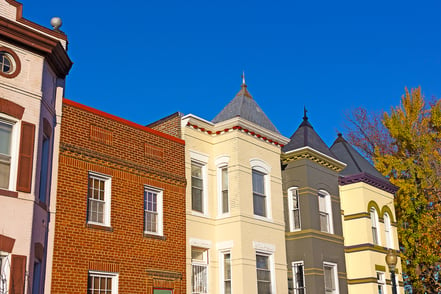As the cool autumn weather turns frosty, homeowners might want to focus on a frequently overlooked but crucial part of home maintenance: the cracks and chips of brick walkways, pavers, front steps and driveways. Beneath those fallen leaves strewn across your exterior hardscaping may lurk hidden safety hazards and cosmetic concerns that winter’s freeze-thaw cycles will only worsen. Understanding the significance of minor problems and quickly mitigating them will save you sizable future repair costs and maintain your historic brick home's integrity and aesthetic value. Here’s some steps to take in preparation to protect exterior brickwork and hardscaping before winter sets in.
What Should You Look for When Inspecting Exterior Hardscaping?
Winter is exceptionally hard on an urban garden’s hardscaping features, including the retaining walls. With brick pathways already subjected to a high level of foot traffic throughout the warmer seasons, winter adds its own concerns to the mix. A combination of snow, ice, melting, and anti-slip measures such as salt or sand takes its toll on even the hardiest exterior brick hardscaping.
After sweeping away the leaves and dirt, carefully inspect your walkways, driveways, patios and front steps for loose bricks, chips and cracks. When examining your stairs, make sure to check mortar joints and ensure there is no missing or damaged mortar. All your exterior hardscaping should be intact, smooth and level. If the surfaces show signs of wear, are loose or uneven, it’s time to call an expert to prevent further damage.
Why Are Chips and Cracks in Exterior Structures Such a Big Concern?
Compromised exterior brick and other hardscaping materials open a pathway for water to infiltrate the building material and the base underneath. As the water goes through winter’s freeze-thaw cycle, the expanding ice pushes cracks wider, allowing even more water in, creating a vicious cycle of damage. Larger amounts of water can erode the packed substrate beneath the hardscaping, washing it away and compromising the structural integrity of the entire feature.
Water isn’t the only problem. Chips and cracks can also invite aggressive weeds to take up residence in the small spaces. Although the plants may be dormant in the late fall, their roots will continue to grow, forcing the cracks wider. By the time winter is over, you could find yourself with a wild urban garden in places you never wanted things to grow.
The Value in Repairing Exterior Urban Structures Now
There are numerous reasons why repairing minor problems now is a critical undertaking. The number one reason is your safety, and that of your family and guests. Large cracks and uneven surfaces create significant tripping hazards, while pooling water creates the perfect conditions for ice to form, leading to slips and falls.
Financially, if the problems are not addressed promptly, they can lead to more costly fixes in the future. It is always less expensive to take care of a minor repair than to replace entire structures. Freeze-thaw cycles and subsequent water damage can also reduce the lifespan of exterior hardscaping, preventing you from realizing the full value of your original investment while paying for its replacement much sooner than anticipated.
Aesthetically, problems caused by winter damage detract from your property's visual appeal, making the exterior look worn-out and poorly maintained. This can hurt your home’s curb appeal and lower its potential value, especially if you might have plans to sell it in the future.
Contact a Professional for Expert Repair
Repairing hardscaping is more than simply bricklaying. Matching your existing features, repairing historic steps with the correct lime-based mortar mixtures and identifying the source of the problem is key to effective repairs and value for money. Hiring a historic brick expert can help ensure your home stays safe and problem-free all winter.
Renaissance Development, experts in traditional tuckpointing methods, specializes in brick repair and restoration projects in Capitol Hill and many other historic neighborhoods in Washington, DC. Contact us today for expert advice on your retaining wall or your historic brick home.
Tags:
Repair, Retaining walls, Exterior brick, Water damage, Hardscaping, Spot tuckpointing, old brick, brick steps, Brick Driveway, Brick Patio, Patio, Backyard Patio, Spalling, tuckpointing, Walkway, Brick Walkway, Historic Brick Home DC, Retaining Walls DC, Brick Retaining Walls, Brick walls, Brick RepairOct 19, 2023 8:30:00 AM


